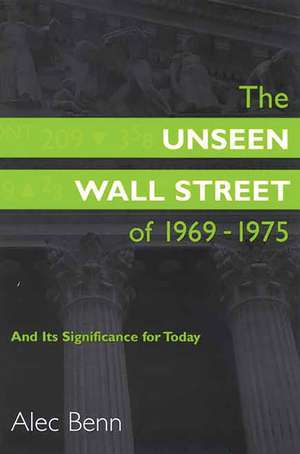The Unseen Wall Street of 1969-1975: And Its Significance for Today
Autor Alec Bennen Limba Engleză Paperback – 29 mar 2002 – vârsta până la 17 ani
| Toate formatele și edițiile | Preț | Express |
|---|---|---|
| Paperback (1) | 237.08 lei 6-8 săpt. | |
| Bloomsbury Publishing – 29 mar 2002 | 237.08 lei 6-8 săpt. | |
| Hardback (1) | 438.67 lei 6-8 săpt. | |
| Bloomsbury Publishing – 29 iun 2000 | 438.67 lei 6-8 săpt. |
Preț: 237.08 lei
Preț vechi: 305.45 lei
-22% Nou
Puncte Express: 356
Preț estimativ în valută:
45.37€ • 47.52$ • 37.60£
45.37€ • 47.52$ • 37.60£
Carte tipărită la comandă
Livrare economică 09-23 aprilie
Preluare comenzi: 021 569.72.76
Specificații
ISBN-13: 9781567205930
ISBN-10: 1567205933
Pagini: 240
Dimensiuni: 156 x 235 x 13 mm
Greutate: 0.33 kg
Editura: Bloomsbury Publishing
Colecția Praeger
Locul publicării:New York, United States
ISBN-10: 1567205933
Pagini: 240
Dimensiuni: 156 x 235 x 13 mm
Greutate: 0.33 kg
Editura: Bloomsbury Publishing
Colecția Praeger
Locul publicării:New York, United States
Notă biografică
ALEC BENN, now retired, was president of Benn & McDonough, Inc., an advertising and public relations agency in New York City serving the financial and investment communities./e Previously a vice president at Doremus & Co., at that time the largest financial services ad agency in the United States, and before that a writer of industry studies at Merrill Lynch, Benn holds an engineering degree from Brown University and has studied writing and economics at New York University and Columbia University. He is author of Advertising Financial Products and Services (Quorum, 1986), The 27 Most Common Mistakes in Advertising, and The 23 Most Common Mistakes in Public Relations. Mr. Benn has also written articles and columns for publications in his fields, a TV drama, and an award-winning play.
Cuprins
PrefaceHow Members of the New York Stock Exchange Gained the Right to Sell Shares in Their Firms to the General Public Despite the Opposition of a Majority of the MembersHow the Central Certificate System Was Introduced and Other Early Bumbling with ComputersThe Hair-Raising Way Brokerage Accounts Came to Be InsuredThe Desirability of Permanent CapitalNegotiating a MergerObstacles to the MergerHow and Why Ross Perot Saved the New York Stock Exchange from Possible CollapseHow the New York Stock Exchange Came Much Closer--Much, Much Closer--to Collapse the Second TimeHow a Giant Investment Firm Very Nearly Went Bankrupt in 1971 Potentially Causing Investors to Lose Millions of Dollars Despite the Existence of the Securities Investors Protection CorporationThe Importance of Management StyleThe Reality of U.S. Government EmploymentHow the U.S. Government Has Tried to Prevent Insider Trading--And Why It Has FailedThe Twists and Turns Toward the Reorganization of the New York Stock ExchangeHow NYSE Commissions, Traditionally Fixed and High, Became Competitive and Low, Despite the Opposition of Members of the New York Stock ExchangeAn Unintended Consequence of the Imposition of Competitive Commission Rates: A Boom in Soft DollarsHow a Defiant Stockbroker Virtually Single-Handedly Enabled All Members of the New York Stock Exchange to Sell AnnuitiesThe Biggest Stock Fraud in the District Attorney's MemoryA Cliff-Hanging Merger MeetingDeja VuHow and Why Discrimination Based on Class and Religion Declined on Wall StreetThe Different Reasons for the Decline in Racial and Gender Discrimination on Wall StreetSignificanceAftermath: The Perils of PartnershipsAppendixStock, Prices, Volumes and Fails 1968-1973Some Statistics Affecting Stock Prices and Volumes 1965-1975BibliographyIndex
















